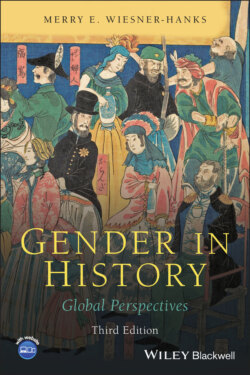Читать книгу Gender in History - Merry E. Wiesner-Hanks - Страница 12
Difference and Intersectionality
ОглавлениеHistorians of women were key voices in debates about the distinction between gender and sex and about categories of sexual and gender identity. They also put increasing emphasis on differences among women, noting that women’s experiences differed because of class, race, nationality, ethnicity, religion, and other factors, and they varied over time. Because of these differences, some wondered, did it make sense to talk about “women” at all? If, for example, women were thought to be delicate guardians of the home, as was true in the nineteenth-century United States, then were Black women, who worked in fields alongside men, really “women”? If women were thought to be inferior and irrational (as they were in many cultures) then was Queen Elizabeth I of England a “woman”? Was “woman” a valid category, the meaning of which is self-evident and unchanging over time, or is arguing for any biological base for gender difference naïve “essentialism”? These historians noted that not only in the present is gender “performative,” that is, a role that can be taken on or changed at will, but it was so at many points in the past, as individuals “did gender” and conformed to or challenged gender roles. Thus it is misguided to think that we are studying women (or men, for that matter) as a sex, they argued, for the only thing that is in the historical record is gender. In the 2000s, some scholars and activists advocated using “woman-identified” or “female-identified” instead of “woman,” as these seemed to better include trans women. (“Woman-identified” had a different meaning in the 1970s, when early feminists used it to mean women who did not look to men for affirmation.) Patriarchy largely disappeared as an analytical framework as well, as it, too, seemed essentialist and falsely universalizing.
Recognizing difference was not enough, asserted some scholars, who stressed that these categories were not simply matters of identity, but also oppression. They noted that feminist scholarship had sometimes taken the experiences of heterosexual white women as normative, and argued that the experiences of women of color must be recognized as distinctive. The nature of oppression is multiplicative rather than additive, and no one identity – race, class, gender, religion, ability, sexual orientation, and so on – should be considered apart from other identities, but is always materialized in terms of and by means of them. The idea that multiple forms of oppression interact and combine was part of the thinking of feminist groups that emerged in the 1960s and 1970s, which is not surprising, as so many founders of women’s liberation had been active in the civil rights and anti-Vietnam War movements, the latter both anti-racist and anti-imperialist. Socialist feminists expanded Marxist analysis of labor exploitation in production to examine paid and unpaid household labor, through which working-class as well as wealthier men benefited from the unpaid work of their female family members. In addition, prosperous women benefited when they could hire poorer women – usually women of color and foreign born – for child care and housecleaning.
Even before the 1960s, Black left feminists such as Louise Thompson Patterson wrote about the “triple exploitation” of race, gender, and class. Feminists of color analyzed what Fran Beal of the Third World Women’s Alliance termed the “double jeopardy” of being both Black and female. In 1977, the Black lesbian feminist Combahee River Collective asserted in a statement mostly written by Barbara Smith: “We are actively committed to struggling against racial, sexual, heterosexual and class oppression, and see as our particular task the development of integrated analysis and practice based on the fact that the major systems of oppression are interlocking. The synthesis of these oppressions creates the conditions of our lives.”2 In 1989, the critical race theorist and feminist legal scholar Kimberlé Crenshaw called this synthesis of oppression “intersectionality,” a concept and word that slowly spread into other academic fields.
Just as gender had earlier, intersectionality moved from academia and feminist activism into ordinary speech. By the 2010s it had itself become a category of identity, with people using “intersectional feminist” to describe themselves on their blogs, Facebook pages, protest signs, T-shirts, and Twitter or Tumblr posts. Many sport a quotation from Flavia Dzodan, a writer who lives and works in Amsterdam, taken from her 2011 blog post on Tiger Beatdown: “My feminism will be intersectional or it will be bullshit.” “Patriarchy” has returned on some of those signs as well: On Wednesdays We Smash the Patriarchy; Destroy the Patriarchy, Not the Planet.
Along with moving from academia into popular culture, the concept of intersectionality has also become increasingly dynamic and global, analyzing (and critiquing) structures of power and oppression that arise from a variety of situations. Scholars have not simply used social groupings drawn from the Western past and present, but have elaborated social categories taken from local understandings as well. To Smith’s Big Four (race, class, gender, and sexuality), scholars have added religion, age grades, ethnicity, and other factors as key social structures operating in the societies they study, past and present. They have also subtracted one or more of the Big Four, arguing, for example, that gender as it is understood in the West was not an important category of analysis or oppression in many sub-Saharan African societies. Sometimes this analysis has been explicitly intersectional – that is, situating itself theoretically within the development of the concept – but more often it has been implicitly so, investigating the ways in which two or more of these social systems operate together in the shaping of individual and group experience, but not necessarily describing this as intersectional.
